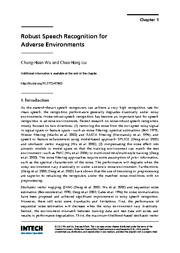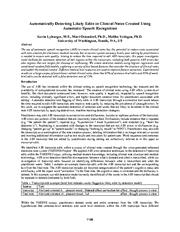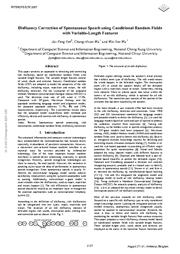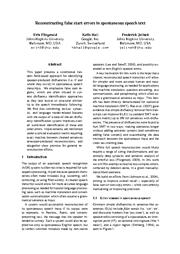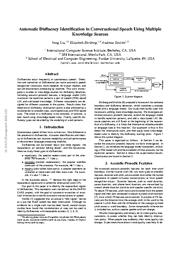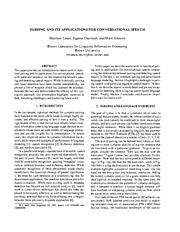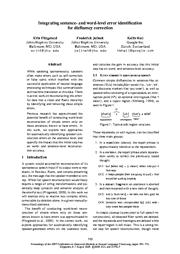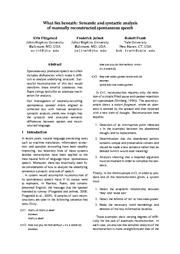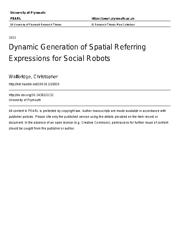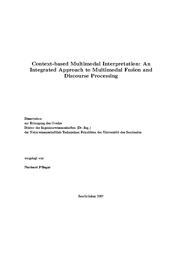A copy of this work was available on the public web and has been preserved in the Wayback Machine. The capture dates from 2017; you can also visit the original URL.
The file type is application/pdf.
Filters
Robust Speech Recognition for Adverse Environments
[chapter]
2012
Modern Speech Recognition Approaches with Case Studies
Dowding and E. Shriberg (1992). Integrating multiple knowledge sources for detection and correction of repairs in human-computer dialog. Proc. of ACL. ...
Wordbased linguistic module consists of a cleanup language model and an alignment model is used for verifying the position of the IP and therefore correcting the edit disfluency. ...
For handling language-related phenomena in edit disfluency, a cleanup language model characterizing the structure of the cleanup sentences and an alignment model for aligning words between deletable region ...
doi:10.5772/47843
fatcat:iwk4m3v44vcp7aujvnhkdzw4yi
Automatically Detecting Likely Edits in Clinical Notes Created Using Automatic Speech Recognition
2018
AMIA Annual Symposium Proceedings
We create detection models using logistic regression and conditional random field models, exploring a variety of text-based features that consider the structure of clinical notes and exploit the medical ...
Experimental results on a large corpus of practitioner-edited clinical notes show that 67% of sentence-level edits and 45% of word-level edits can be detected with a false detection rate of 15%. ...
The data used was provided through the support of grant number R21HS023631 from the Agency for Healthcare Research and Quality (AHRQ). ...
pmid:29854187
pmcid:PMC5977669
fatcat:6cemlu6pu5f77c4qbxlwcqsdoe
Disfluency correction of spontaneous speech using conditional random fields with variable-length features
2007
Interspeech 2007
unpublished
This paper presents an approach to detecting and correcting edit disfluency based on conditional random fields with variable-length features. ...
The experimental results show that the proposed model outperforms other methods and efficiently detects and corrects edit disfluency in spontaneous speech. ...
Yeh and Wu integrated the alignment model and language model to build an edit disfluency cleanup model [14] . ...
doi:10.21437/interspeech.2007-582
fatcat:4xcirpcdhfauhcxealn44kh3ou
Reconstructing false start errors in spontaneous speech text
2009
Proceedings of the 12th Conference of the European Chapter of the Association for Computational Linguistics on - EACL '09
unpublished
We find that combining lexical, syntactic, and language model-related features with the output of a state-of-the-art disfluency identification system improves overall word-level identification of these ...
This paper presents a conditional random field-based approach for identifying speaker-produced disfluencies (i.e. if and where they occur) in spontaneous speech transcripts. ...
Any opinions, findings, conclusions, or recommendations expressed in this material are those of the authors and do not necessarily reflect the views of the supporting agency. ...
doi:10.3115/1609067.1609095
fatcat:rsw6nysquzgtvoyp4nglgm3u7q
Automatic disfluency identification in conversational speech using multiple knowledge sources
2003
8th European Conference on Speech Communication and Technology (Eurospeech 2003)
unpublished
This work investigates a number of knowledge sources for disfluency detection, including acoustic-prosodic features, a language model (LM) to account for repetition patterns, a part-of-speech (POS) based ...
Detection and correction of disfluencies can make automatic speech recognition transcripts more readable for human readers, and can aid downstream processing by machine. ...
Acknowledgments The authors gratefully acknowledge Luciana Ferrer for her help with the prosodic feature extraction, and Mary Harper and Barbara Peskin for helpful comments and discussion. ...
doi:10.21437/eurospeech.2003-332
fatcat:jalknwbwxfca5oyjree46vhp2e
Parsing and Its Applications for Conversational Speech
Proceedings. (ICASSP '05). IEEE International Conference on Acoustics, Speech, and Signal Processing, 2005.
This paper provides an introduction to recent work in statistical parsing and its applications for conversational speech, with particular emphasis on the relationship between parsing and detecting speech ...
While historically parsing and repair detection have been studied independently, we present a line of research which has spanned the boundary between the two and demonstrated the efficacy of this synergistic ...
In Section 4, we describe repairs in more detail and present an approach for detecting them using our parser-based language model. ...
doi:10.1109/icassp.2005.1416465
dblp:conf/icassp/LeaseCJ05
fatcat:yfmudgilnjchjlrxnunxeg2vj4
Integrating sentence- and word-level error identification for disfluency correction
2009
Proceedings of the 2009 Conference on Empirical Methods in Natural Language Processing Volume 2 - EMNLP '09
unpublished
There is active work on reconstructing this errorful data into a clean and fluent transcript by identifying and removing these simple errors. ...
While speaking spontaneously, speakers often make errors such as self-correction or false starts which interfere with the successful application of natural language processing techniques like summarization ...
Any opinions, findings, conclusions, or recommendations expressed in this material are those of the authors and do not necessarily reflect the views of the supporting agency. ...
doi:10.3115/1699571.1699612
fatcat:dhemjmdo2fd7fohhg73we22fla
What lies beneath
2009
Proceedings of the Joint Conference of the 47th Annual Meeting of the ACL and the 4th International Joint Conference on Natural Language Processing of the AFNLP: Volume 2 - ACL-IJCNLP '09
unpublished
between spoken and reconstructed language. ...
Our investigation of naturally-occurring spontaneous speaker errors aligned to corrected text with manual semanticosyntactic analysis yields new insight into the syntactic and structural semantic differences ...
Any opinions, findings, conclusions, or recommendations expressed in this material are those of the authors and do not necessarily reflect the views of the supporting agency. ...
doi:10.3115/1690219.1690251
fatcat:rsgxiwcugva7rjsv27gaw67pdm
Text-to-Speech Synthesis Using Found Data for Low-Resource Languages
2019
While it takes a great deal of time and resources to collect a traditional text-to-speech corpus for a given language, we may instead be able to make use of various sources of "found" data which may be ...
Typically, building a high-quality voice requires collecting dozens of hours of speech from a single professional speaker in an anechoic chamber with a high-quality microphone. ...
Acknowledgments This thesis would not have been possible without the mentorship and guidance of my advisor, ...
doi:10.7916/d8-vdzp-j870
fatcat:bw4g7ng5azbzxixayxlqyxtnky
Dynamic Generation of Spatial Referring Expressions for Social Robots
[article]
2021
I start by looking at a Robot Assisted Language Learning scenario, in which the robot attempts to encourage the use of spatial language in a quiz based game. ...
I present the following thesis: A robot that is able to use dynamic description methods –using vague initial language with the ability to further repair for generating spatial referring expressions as ...
Acknowledgements
ACKNOWLEDGEMENTS This work was supported by the EU Horizon 2020 L2TOR project (grant 688014) the and EU H2020 Marie Sklodowska-Curie Actions project DoRoThy (grant 657227). ...
doi:10.24382/1232
fatcat:bwumaknjsbe6jdfpw7niuv4kri
Proceedings of the First Workshop on Natural Language Processing for Indigenous Languages of the Americas
2021
A couple of thousand languages and dialects, at present divided into 17 large families and 38 small ones, with several hundred unclassified single languages, are on record. ...
In one small portion of the area, in Mexico just north of the Isthmus of Tehuantepec, one finds a diversity of linguistic type hard to match on an entire continent in the Old World. ...
This article is an output of a research project implemented as part of the Basic Research Programme at the National Research University Higher School of Economics (HSE University). ...
doi:10.5167/uzh-203436
fatcat:6vbdg7jlkzhrhof66v2zvtyejm
Context-based multimodal interpretation : an integrated approach to multimodal fusion and discourse processing
[article]
2008
I am particularly thankful for the interesting discussions and for the valuable insights you provided. ...
Web Ontology Language-OWL The Web Ontology Language (OWL) is a markup language designed to enable the exchange of data using an ontology. ...
As a consequence, a language model based speech recognizer is only able to recognize exactly the sentences available in the language model. ...
doi:10.22028/d291-25919
fatcat:w276wugztnbvhe742q44swlvnq

